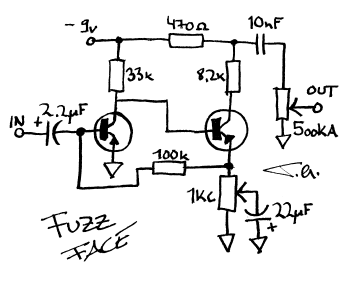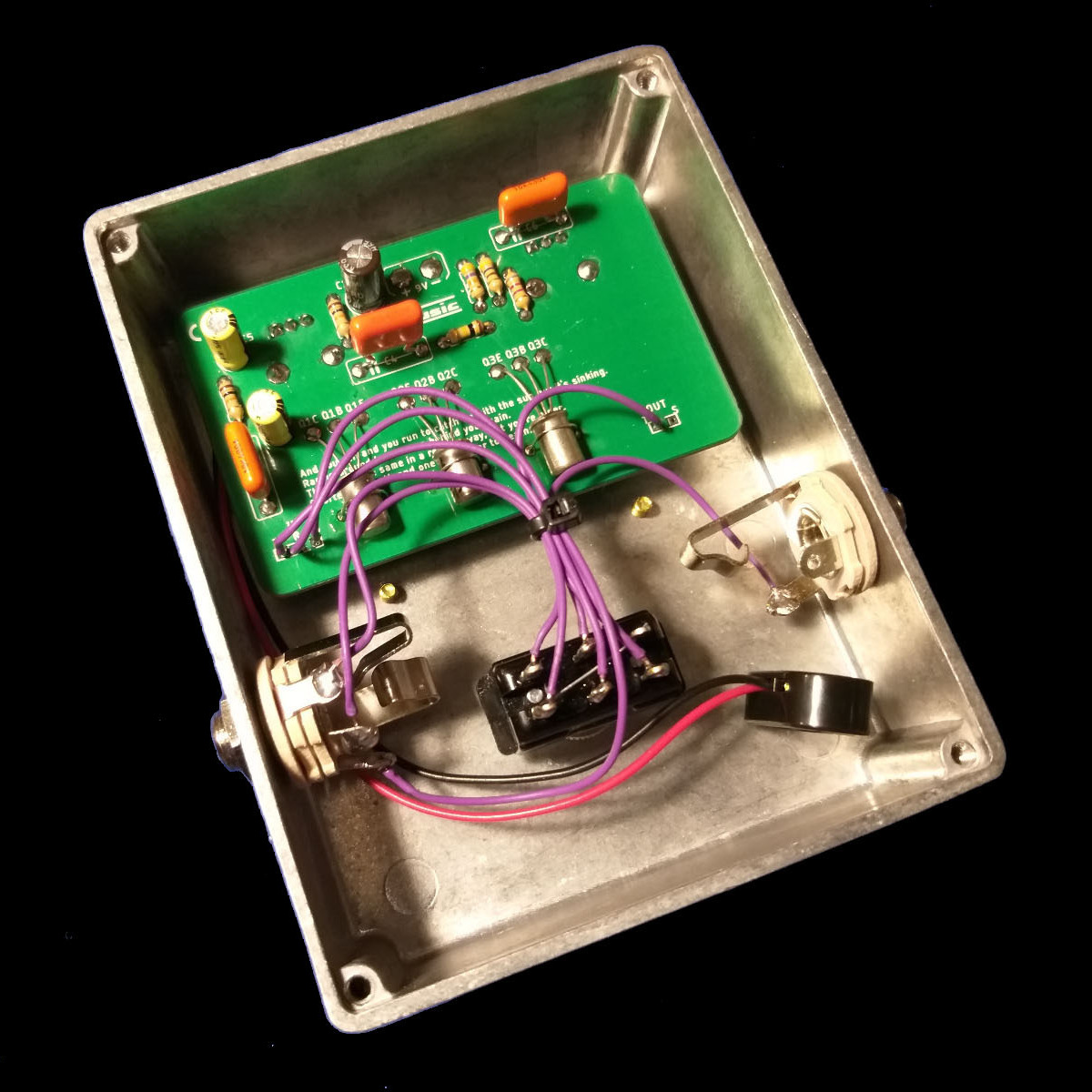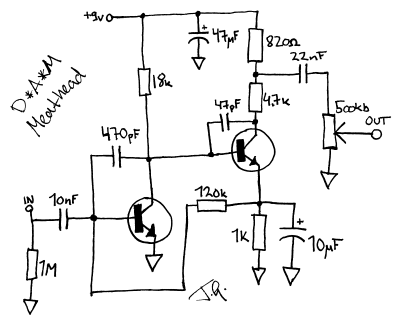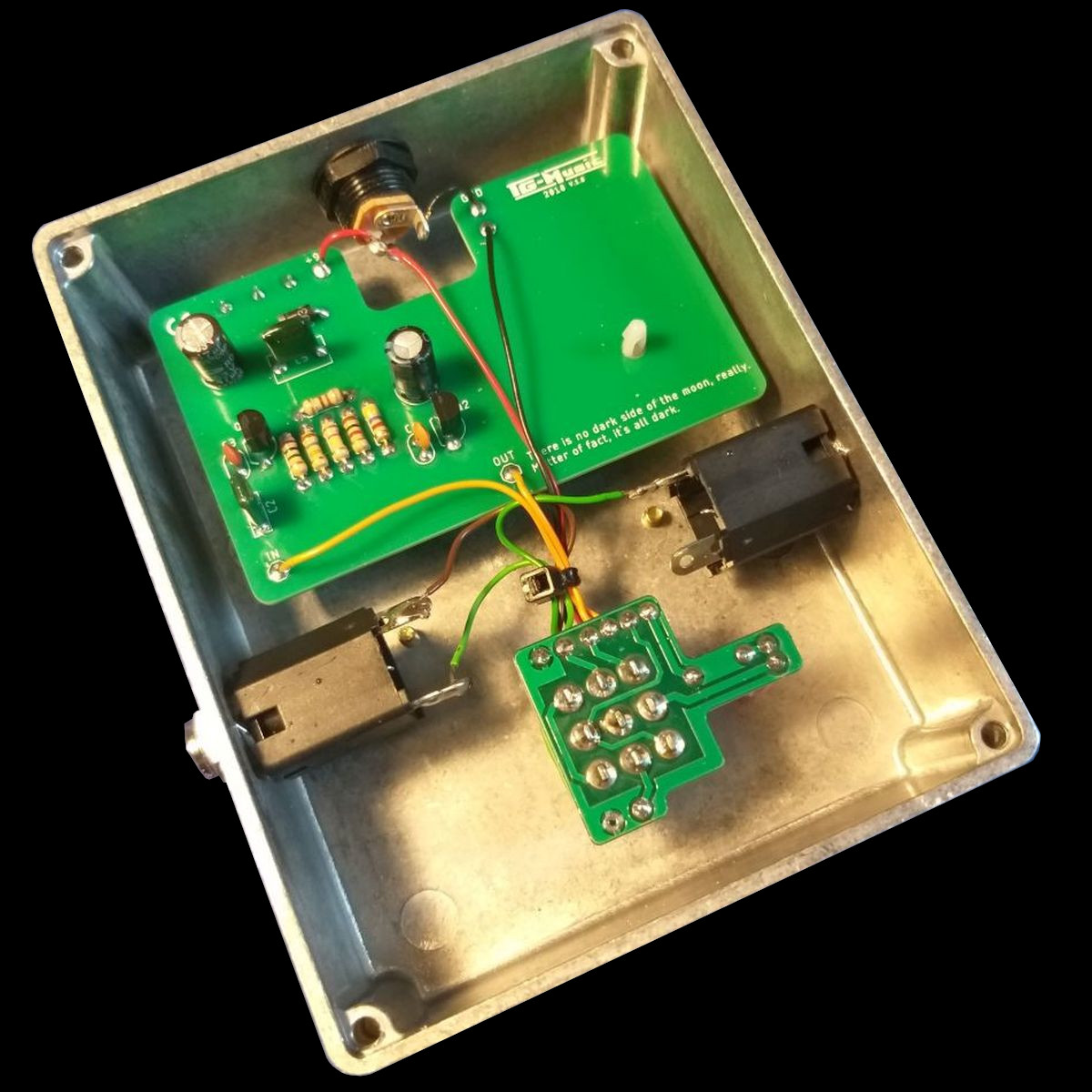Fuzz Face: The legend
 The fuzz face is a legend. I doubt anyone can count all the fuzz face variants, clones and "original circuits" based on it since its release in 1966. In this article I try to give my two cents for this topic. It seems to be ever popular thing to do, so why not.
The fuzz face is a legend. I doubt anyone can count all the fuzz face variants, clones and "original circuits" based on it since its release in 1966. In this article I try to give my two cents for this topic. It seems to be ever popular thing to do, so why not.
Germanium Fuzz
As you can see from the schematic, fuzz face is very simple circuit. In the first picture is the classic circuit with PNP germanium transistors. This is what you would build if you are after the original germanium fuzz face. Transistors in this circuit are critical. Germanium transistors are very leaky devices and they have very inconsistent β (beta)*. Many retailers are selling ready matched sets of transistors. Most often these are currently (or recently) manufactured AC128. Everyone seems to be after the Q1 = 70-85 and Q2 = 130-140 hFE values for fuzz face. But don't get stuck on these numbers. I would say +/-20% is still worth trying and can sound just as good as anything else. However, you can't measure these transistors with multimeter, because leakage will mess the meter, resulting in much too high hFE reading. For further reading see Picking transistors for FF Clones by R.G. Keen
 There are many ways around these problems. As I mentioned earlier, you could get a ready matched set of ge-transistors. Do this if you are making your first or second fuzz. Other solution would be to buy a batch of 20 or more transistors and select them yourself. I have found that Russian MP20 (МП20Б) is an excellent alternative to western transistors**. MP20 is inexpensive and readily available in larger quantities. I got 10 two transistors sets from the batch of 50pcs. and about ten more suitable for rangemaster treble booster. The cost was less than 15 euros.
There are many ways around these problems. As I mentioned earlier, you could get a ready matched set of ge-transistors. Do this if you are making your first or second fuzz. Other solution would be to buy a batch of 20 or more transistors and select them yourself. I have found that Russian MP20 (МП20Б) is an excellent alternative to western transistors**. MP20 is inexpensive and readily available in larger quantities. I got 10 two transistors sets from the batch of 50pcs. and about ten more suitable for rangemaster treble booster. The cost was less than 15 euros.
Simple trick to make most transistors work in fuzz face is "the fulltone trimmer". This is 10k trimmer in place of 8,2k resistor. You should then adjust the trimmer for the best sound, or about 3,5-5 volts measured from Q2 collector. This is a "brute force" method, and it's not the proper way to bias a transistor. However, it does work ok if you are building pedals for sale. Still by far the best way is selected transistors.
Here's my Eagle PCB-files (.sch and .brd) for Solasound Tone Bender mkII germanium fuzz: Solasound Tone Bender mkII
Silicon Fuzz
 That was (for now) all about germanium stuff. How about silicon? In Finland silicon is often confused with silicone. Don't make that mistake. One is for semiconductors and the other is for bathrooms and boobs (go figure). So on the right side of the screen you see a schematic of a very good version of silicon fuzz face. D*A*M Meathead is an excellent variant of an old classic. Original transistors are Q1 = 2N3904 and Q2 = BC182L. Again, Q2 is the higher gain transistor.
That was (for now) all about germanium stuff. How about silicon? In Finland silicon is often confused with silicone. Don't make that mistake. One is for semiconductors and the other is for bathrooms and boobs (go figure). So on the right side of the screen you see a schematic of a very good version of silicon fuzz face. D*A*M Meathead is an excellent variant of an old classic. Original transistors are Q1 = 2N3904 and Q2 = BC182L. Again, Q2 is the higher gain transistor.
470pF and 47pF caps from the transistor collectors to base smooth out the typical harshness of the silicon fuzz face. This is a really nice tweak, and well worth addition to any other silicon fuzz face variants as well.
Original Meatheads are very expensive, but you can clone your own for very little money. All the parts are readily available, and no transistor selection or matching is needed. You can try practically any silicon NPN transistors. They do affect the sound at least somewhat. Again, "different sounding components" can make one go insane so be advised.***
 As you can see, Meathead has no "Fuzz" control. If you want or need one, you can add 1k potentiometer to Q2 emitter just like in the germanium version. You should use 1k reverse logarithmic potentiometer for smooth response. I see no point of it, as it's always set to full gain anyway.
As you can see, Meathead has no "Fuzz" control. If you want or need one, you can add 1k potentiometer to Q2 emitter just like in the germanium version. You should use 1k reverse logarithmic potentiometer for smooth response. I see no point of it, as it's always set to full gain anyway.
I would like to point out you have to pay some big bucks for the original. I've seen prices up to 300€ and that's a lot for fuzz face. Even if it is as good as this. Build your own, it will cost you about 30€, if that. And of course, you can build yours in a smaller box. This will be a good candidate for 1590A project, if that is your thing.
Here's my Eagle PCB-files (.sch and .brd) for D*A*M Meathead silicon fuzz: D*A*M Meathead
Conclusion
If you like to tip your toes into the fuzzland, both of the circuits presented here are well worth trying. Ge-fuzz is more of a challenge to tune up, but it's well worth the trouble in the end. Si-version is much more straight forward to build, and Meathead is a readily tuned and ready to go. Whichever you choose to build, take it always as a learning experience. Your patience will be rewarded with great sounds you made yourself!
*You can think of β as amplification factor of transistor. So, if a transistor has a β of 100, the base current that goes into it is amplified by 100.
** ***Some people on the internet are furious about the "sound of transistors", and go long ways to tell everyone which ones are the best. Don't get sucked in to this. Use whatever you can get your hands on. Even if it sounds crap, you now know better because you have real world experience.
